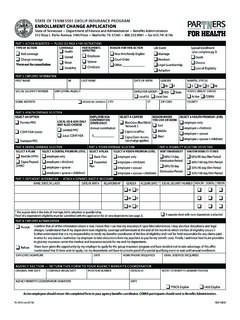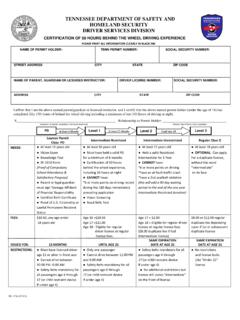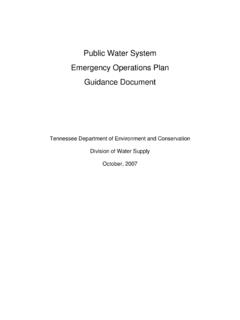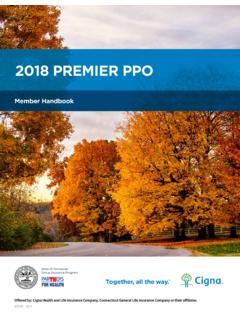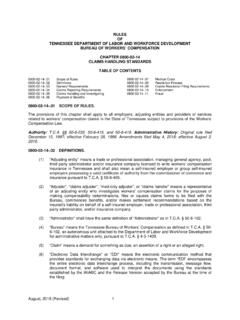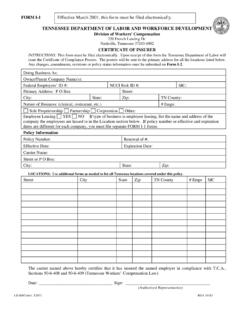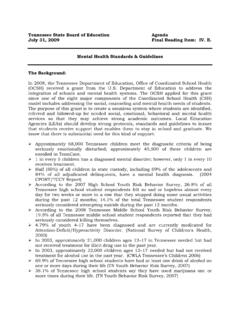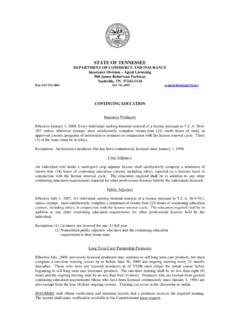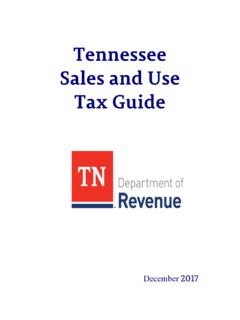Transcription of Landfill Leachate Collection Systems Reviewing the Basics
1 Landfill Leachate Collection SystemsReviewing the Basics47th AnnualEnvironmental Show of the SouthMay 16-18, 2018 Sponsored by:Prepared by:Outline Introduction Purpose Regulatory Requirements system Components Drainage and Collection Removal and Storage Treatment and Disposal Installation and Other Applications Operation & Maintenance Minimizing Leachate Generation Summary and ClosingIntroductionLeachate Collection and Removal system (LCRS) Required feature at Class I Facility Reqmt to limit Leachate head Properly designed and functioning LCRS is important Management of Leachate among highest operating costsLet s review Basics of of LCRS Systems in place prevent Leachate from leaving site, including.
2 Liner, Leachate , Storm Water, LFG, Daily and Final Covers Collection /removal system is key componentof containment system Req d to manage Leachate to < 1 Capture Leachate produced Collect and remove Leachate Leachate :liquid (primarily rainwater) that passes thru waste(Credit: Qian, 1993)Regulatory Requirements - TNTDEC Chapter 0400-11-01-04(4)(a):(5) LCRS system required above liner that is designed, constructed, maintained, and operated to collect / remove Leachate Materials chemically resistant to waste managed and Leachate expected to be generated Sufficient strength and thickness to prevent collapse under pressures exertedRegulatory Requirements - TNTDEC Chapter 0400-11-01-04(4)(a):(7) LCRS must meet following reqmts (designed, constructed, operated, and maintained).
3 Leachate depth over liner <= 1 (referencing 25-yr, 24-hr storm infiltration vol thru intermediate cover) Leachate interception surfaces / piping to function without clogging throughout post-closure period Leachate Collection reservoirs must: Be constructed such that collected Leachate is contained Have sufficient capacity to store the volume of Leachate expected to be generated in 30 days Have a reliable and convenient means of detecting the level and sampling of collected leachateRegulatory Requirements - TNTDEC Chapter 0400-11-01-04(4)(a):(8) Collected Leachate : Managed in accordance w/ appl regs Sampled and analyzedRegulatory Requirements Others Refer to specific state regulations All states little different more/less detail Basics , at min, addressed in most if not all Most states allow flexibility in alternative designs K Y, N C , S C , G A , A L m i n i m a l t o m o re d e t a i l KY: main (8 ) and lateral (4 ) pipes noted, and 50 flow distance IL some detail Drainage system : head level, precip, thickness, hyd conductivity Collection system : pipes, cleaning, materials Treatment and Disposal system : combination of options Monitoring.
4 Collect and test WI very detailed dictates head level, thickness, hyd conductivity, infiltration, slopes, pipe spacing, cleanout lengths, sizes, gradations, Components -Drainage and Collection SystemDesign Details and Layout Drainage layer above base liner (sand, gravel, geocomposite) system of perforated piping w/ aggregate in trenches Aggregate-filled sumps (low points) w/ access risersTyp Design Criteria Min 1 thick granular drainage blanket (or geosynthetic media) Saturated hydraulic conductivity 1x10-3cm/sec to 1 cm/sec Gradation limits and limits on material content Placement of aggregate backfill (under, around, over piping) Gradation of trench aggregate not clog perforated pipe Min dia for Collection pipes = 6 (Sch 80 PVC or equiv HDPE) Cleanout risers at ends of Leachate Collection pipes and sumps Limits on max cleanout lengths (1000 , 1200 , 2000 )Typ Layout Criteria Drainage distance (spacing) based on demonstrating < 1 head Grading 1% slopes to Collection piping, min along lines(Credit: internet source)Drainage and Collection SystemDesign Analyses Leachate generation: via HELP Model (water balance calc for x-section of Landfill based on climatologic and geologic inputs) Leachate head and flow.
5 Via HELP Model, McEnroe Eq, others Leachate pipe flow capacity ( , drainage calcs) Leachate Collection pipe strength calcs (various methods, total load w/ size) Application of methodology/assumptions Factors affecting Leachate head or mounding Percolation rate, hyd cond of drainage layer, flow distance to pipes, slope of base(Credit: internet source)Typical Design DetailsBase liner, Leachate Collection layer, and pipe trenchDesign LayoutsBase grading and Leachate Collection system plan layouts (w/ grading, spacing, sumps, and cleanouts) system Components -Removal and Storage SystemDesign Details and Layout Aggregate-filled sumps (low points) w/ access risers for removal Cells generally have own sump located at perimeter for access Forethought master plan avoid future conflicts Sideslope Systems (vertical manholes as early designs.)
6 Change over time) Sideslope sump riser pipes (18 min dia) w/ submersible pumps (transducer controlled or manually activated) Top of slope termination (sometimes vault) where removedRemoval and Storage SystemDesign Analyses Sump volume sizing Leachate storage sizing calcs (min capacity reqmts) HELP Model results or other dictated values Application of methodology/assumptions Transfer and Storage Pumped to loadout connection or forcemain Components (FM piping, risers, manholes, tanks, located outside lined areas (sec containment)) Above-ground storage tanks, ponds, recirculation, trucks, offsite disposal Tanks equipped w/ pumps and load-out facility Pumped to tanker truck, indirect POTW sewer connection, or direct discharge to environmentTypical Design DetailsCross-section thru sideslope sump and cleanout risers (current), and vertical manhole (older)Examples of Perimeter Sump Controls(Credit.
7 Various internet sources) system Components Treatment and Disposal SystemTransfer Systems route to storage/load-out facilitiesStorage Systems (capacity and secondary containment reqmts, material compatible w/ Leachate , no malodor)Treatment Options Onsite Treatment and Pretreatment (tanks, ponds, filtration Systems ) Offsite treatment works transport to licensed waste water pretreatment or treatment plant for treatment and disposal via hauling or sewer connection Leachate recirculation or recycling Other management (treatment/disposal) alts Direct discharge to environmentInstallationConstruction / Installation Large earthmoving and excavation operation Place or install liner Grade trenches and sumps Place aggregate and install piping Install drainage blanket CQA, especially during aggregate, pipe, and drainage blanket placement Good construction and documentation is KEY Pay particular attention to field construction practices Avoid debris accumulation in pipes Avoid poor pipe joints which can impede drainage Consider post-construction flushTypical Installations (Credit: various internet sources)Typical Installations (Credit.
8 Site installations andvarious internet sources)Other Applications Horizontal Collectors Leachate seeps Remediation Elevated temperature sites (multiple layers of systematically spaced lines collect/remove accumulated Leachate and/or cool waste mass) LFG extraction Systems Leachate extraction Systems Leachate recirculation Systems PhytoremediationOperation & MaintenanceOperation Collection system for gravity flow to low points where Leachate is withdrawn Free-draining from pipes to sumps ( , Collection points) submersible pumps for removal Forcemain piping transfers to tanks, temp tanker trucks, sewer, or loadout to trucks Electronically programmed pressure transducer ensures Leachate level on top of liner < 1 (automatically)
9 Manually operated and/or manual checksLeachate Recirculation Leachate is recirculated into LF via pipe system May not be as prevalent Advantages and disadvantagesOperation & MaintenanceMonitoring/Inspections Leachate level detection system maintains levels w/ routine operations Routine monitoring of levels Components and levels also monitored per routine facility inspections and sampling Difficult since majority of system is buried Inspections Look for evidence of clogging or general system repair Noting evidence of problems Measuring problems (documentation at installation critical; use for review and justification if problems later) Act as neededOperation & MaintenanceMaintenance/Cleaning ( , problems exp d) Cleaned and maintained as necessary Evidence of clogging or general system repair Necessity for cleaning based on irregularities in Collection system performance (volumes, pumps, etc.)
10 Build-up of scale, bio-rock, clogging Flow and/or pump issuesExperiences at Elevated Temperature Sites Increasing numbers of MSW LF s reporting unusually hot temp s Landfills operated w/ Leachate Collection provisions are generally cooler than thicker landfills where liquids are added One (of many) symptoms Leachate Collection system fouling / clogging Accelerated schedule of pipe jetting and pump maintenance to keep LCS clear of scaleThere s got to be a better way, or at least a good way ?!?Pipe Cleaning Why & WhenPurpose Facilitate flow Remove bio-mass, debris Open blocked perforations Identify existence of damageFrequency Varies greatly From: as-needed to routine to emergency Annually, semi-annually, bi-annually, other Refer to specific state regulations: NC - cleaned annually or demonstrate, camera inspection reqmts also Others permit renewal, const completion, annually Check requirements, rules, billsSideslope Sump Riser Pump (typ)(Credit.)
